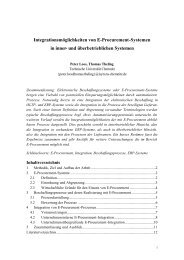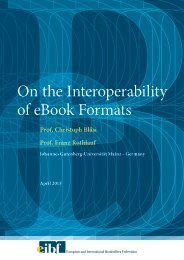Hedonic and Utilitarian Motivations of Social Network Site Adoption
Hedonic and Utilitarian Motivations of Social Network Site Adoption
Hedonic and Utilitarian Motivations of Social Network Site Adoption
You also want an ePaper? Increase the reach of your titles
YUMPU automatically turns print PDFs into web optimized ePapers that Google loves.
a different age group. For example, it is possible that, in contrast to our findings, the influences <strong>of</strong><br />
Perceived Ease <strong>of</strong> Use on Behavioral Intention to Use <strong>and</strong> Perceived Usefulness are significant for<br />
older people that are not experienced with the Internet, or for new users <strong>of</strong> SNSs. Hence, future<br />
studies should test the influences <strong>of</strong> Perceived Enjoyment, Perceived Usefulness, <strong>and</strong> Perceived<br />
Ease <strong>of</strong> Use using different sample structures in order to improve our underst<strong>and</strong>ing <strong>of</strong> the<br />
determinants <strong>of</strong> SNS adoption within different demographic groups.<br />
Despite these limitations, our empirical study supports our argumentation that SNSs are dual<br />
information technologies determined both by hedonic <strong>and</strong> utilitarian motivations. Hence, future<br />
studies should consider both the hedonic <strong>and</strong> utilitarian aspects <strong>of</strong> SNSs.<br />
References<br />
1. Ajzen, I. (1991). The theory <strong>of</strong> planned behavior. Organizational Behavior <strong>and</strong> Human Decision<br />
Processes, 50 (2), 179-211.<br />
2. Ajzen, I. <strong>and</strong> Fishbein, M. (1980). Underst<strong>and</strong>ing attitudes <strong>and</strong> predicting social behavior.<br />
Prentice-Hall, Englewood Cliffs, NJ.<br />
3. Alarcón-Del-Amo, M.-D.-C., Lorenzo-Romero, C. <strong>and</strong> Gómez-Borja, M.-A. (2012). Analysis<br />
<strong>of</strong> acceptance <strong>of</strong> social networking sites. African Journal <strong>of</strong> Business Management, 6 (29),<br />
8609-8619.<br />
4. Alexa (2012). Top sites. http://www.alexa.com/topsites/global (Accessed 2012-12-31).<br />
5. Bagozzi, R.P., Gopinath, M. <strong>and</strong> Nyer, P.U. (1999). The role <strong>of</strong> emotions in marketing. Journal<br />
<strong>of</strong> the Academy <strong>of</strong> Marketing Science, 27 (2), 184-206.<br />
6. Batra, R. <strong>and</strong> Ray, M.L. (1986). Affective responses mediating acceptance <strong>of</strong> advertising.<br />
Journal <strong>of</strong> Consumer Research, 13 (2), 234-249.<br />
7. Bonds-Raacke, J. <strong>and</strong> Raacke, J. (2010). Myspace <strong>and</strong> facebook: Identifying dimensions <strong>of</strong> uses<br />
<strong>and</strong> gratifications for friend networking sites. Individual Differences Research, 8 (1), 27-33.<br />
8. Boyd, D.M. <strong>and</strong> Ellison, N.B. (2007). <strong>Social</strong> network sites: Definition, history, <strong>and</strong> scholarship.<br />
Journal <strong>of</strong> Computer-Mediated Communication, 13 (1), 210-230.<br />
9. Brief, A.P. <strong>and</strong> Aldag, R.J. (1977). The intrinsic-extrinsic dichotomy: Toward conceptual<br />
clarity. Academy <strong>of</strong> Management Review, 2 (3), 496-500.<br />
10. Byrne, B.M. (2001). Structural equation modeling with amos: Basic concepts, applications, <strong>and</strong><br />
programming. Lawrence Erlbaum Associates, Mahwah, NJ.<br />
11. Chang, S.-H., Chou, C.-H. <strong>and</strong> Yang, J.-M. (2010). The literature review <strong>of</strong> technology<br />
acceptance model: A study <strong>of</strong> the bibliometric distributions. PACIS 2010 Proceedings. Paper<br />
158.<br />
12. Chesney, T. (2006). An acceptance model for useful <strong>and</strong> fun information systems. Human<br />
Technology, 2 (2), 225-235.<br />
13. Childers, T.L., Carr, C.L., Peck, J. <strong>and</strong> Carson, S. (2001). <strong>Hedonic</strong> <strong>and</strong> utilitarian motivations<br />
for online retail shopping behavior. Journal <strong>of</strong> Retailing, 77 (4), 511-535.<br />
14. Davis, F.D. (1989). Perceived usefulness, perceived ease <strong>of</strong> use, <strong>and</strong> user acceptance <strong>of</strong><br />
information technology. MIS Quarterly, 13 (2), 319-340.<br />
15. Davis, F.D., Bagozzi, R.P. <strong>and</strong> Warshaw, P.R. (1989). User acceptance <strong>of</strong> computer<br />
technology: A comparison <strong>of</strong> two theoretical models. Management Science, 35 (8), 982-1003.<br />
16. Davis, F.D., Bagozzi, R.P. <strong>and</strong> Warshaw, P.R. (1992). Extrinsic <strong>and</strong> intrinsic motivation to use<br />
computers in the workplace. Journal <strong>of</strong> Applied <strong>Social</strong> Psychology, 22 (14), 1111-1132.<br />
12







